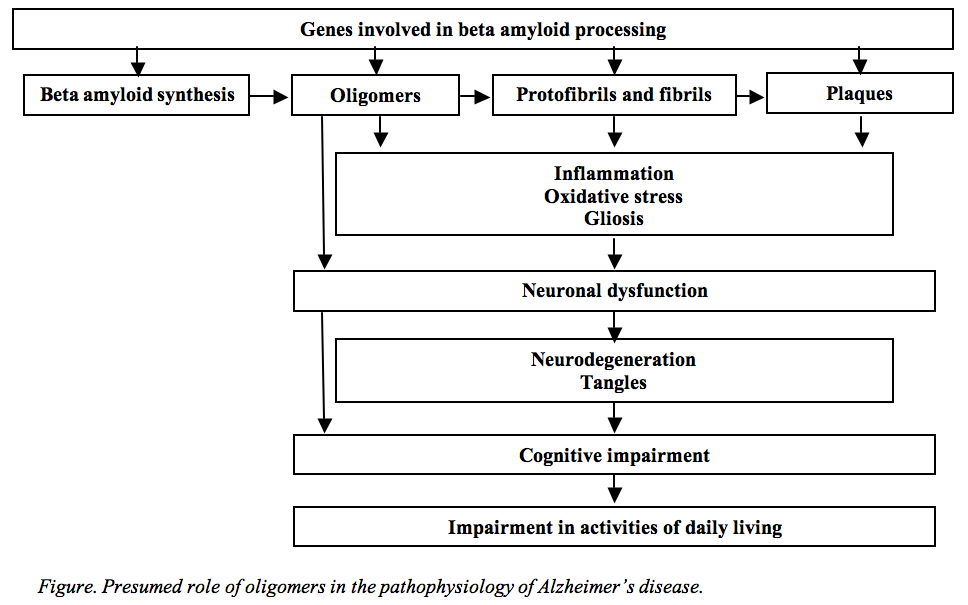|
Title: Beta amyloid oligomers in the early diagnosis of AD and as marker for treatment response
Acronym: EDAR
Contract number: 37670
Project type: STREP
EC contribution in euro: 621002
Starting date: 1 January 2007
Duration: 36 months
Background and objectives:
Alzheimer’s disease (AD) is one of the most common neurodegenerative disorders. There are yet no accurate biomarkers for the early stage of the disease. The goal of the project is to develop new diagnostic markers of Alzheimer’s disease (AD) for the early diagnosis and for the monitoring of treatment response in drug trials. The project focuses on beta amyloid oligomers and the effect of genes involved in beta amyloid processing on these oligomers. Oligomers have been recognized as a key pathogen in AD only recently (see figure).
Due to their low concentration, oligomers cannot be measured with regular techniques. In the present study, ultra-sensitive assays will be used in order to measure oligomers in vivo. Thus, the project will bring recent scientific discoveries in the early pathophysiology of AD to clinical application using innovative technological methods.
The project has the following objectives:
- To develop an assay for the detection of beta amyloid oligomers in cerebrospinal fluid (CSF) and plasma using ultra-sensitive multiplex immuno-polymerase chain reaction (IPCR) with nano-structured DNA-protein conjugates.
- To measure oligomers using the IPCR and immunoprecipitation assay in subjects with AD, other types of dementia, mild cognitive impairment, and control subjects.
- To investigate whether genes involved in beta amyloid processing modify the levels of beta amyloid oligomers.
- To investigate the diagnostic value of beta amyloid oligomers in CSF, serum, and plasma in subjects with AD across the disease spectrum from MCI to mild dementia.
- To investigate the change over time of beta amyloid oligomers in CSF and plasma.
Approach and methodology:
The project consists of 6 workpackages.
Workpackage 1. Biomarker analyses
Aim of this workpackage is measure oligomers in CSF, plasma, and serum. In addition, other biomarkers for AD will be measured such that the diagnostic accuracy of the oligomers can be compared with that of the other biomarkers. Oligomers will be measured using two different techniques:
1. Immunoprecipitation in combination with ELISA.
2. Immuno-polymerase chain reaction (IPCR) using nano-structured DNA-protein conjugates.
3. Assay for beta amyloid aggregates
Moreover, autoantibodies against beta amyloid oligomers will be measured.
Most of the tasks in this workpackage are related to the development of the IPCR assay. It is aimed to develop an IPCR assay for several different oligomer species as different oligomer subspecies may have different diagnostic properties. The IPCR development will start with existing antibodies against beta amyloid oligomers as a proof of concept for the feasibility of IPCR to measure oligomers. In addition, new antibodies will be raised against a number of oligomer subtypes. The selection of these antibodies is a stepwise process. Different oligomer subtypes will be synthesized and antibodies and ELISA’s will be developed against these oligomers. The clinical relevance of these antibodies for AD pathology will be investigated in in-vitro and animal models of AD. On the basis of these experiments, a number of antibodies will be selected which will be coupled to the IPCR probe. Using these antibodies, a multiplex IPCR assay will be developed.
Beta amyloid aggregates will be measured using surface-FIDA, an IPCR based aggregation assay, and a sandwich ELISA with the VU-α-abeta 1-17 antibody as capture and detection antibody.
Finally, oligomers and beta amyloid aggregates will be measured in CSF and plasma. In addition, we will measure in CSF beta amyloid 1-42, total tau and hyperphosphorylated tau at threonine 181, markers for inflammation and oxidative stress, neurofilaments, heart-type fatty acid binding protein, and serum amyloid P
Workpackage 2. Genetic analyses
Aim of this workpackage is to genotype a number of genes involved in beta amyloid processing and to store DNA for future analysis. The genes included in the analysis are genes coding for apolipoprotein E, insulin degrading enzyme, and CYP46.
Workpackage 3. Data collection clinical studies
Aim of the workpackage is to collect a large clinical data set in which the diagnostic accuracy of the markers for AD can be validated and in which the change over time of the markers in AD can be tested.
Clinical data and CSF and blood samples will be collected of 100 subjects with AD, 250 subjects with mild cognitive impairment (a prodromal stage of AD), 100 subjects with other types of dementia, and 50 control subjects. In order to investigate the potential of beta amyloid oligomers to be used as marker of treatment response, cerebrospinal fluid samples and blood samples will be collected 9 and 18 months after baseline in 60 subjects with AD and 60 with mild cognitive impairment.
The clinical assessment at all visits consists of a clinical interview, the MMSE, the Clinical Dementia Rating scale, the Neuropsychiatric Inventory, and a neuropsychological test protocol.
Workpackage 4. Data analysis
Aim of the workpackage is to analyze the data collected in workpackages 1 to 3 in order to determine the diagnostic accuracy of the oligomer assay for the diagnosis of AD and the potential utility of oligomers as marker of treatment response.
Workpackage 5. Dissemination and exploitation
Aim of this workpackage is disseminate and exploit the findings from workpackage 1 to 4 and to reach the potential users.
Workpackage 6. Project management
The general purpose of the project management is to ensure achievement of the objectives within budget and time-scales.
Expected outcomes:
- Antibodies against oligomers
- IPCR antibody-DNA probe and multiplex IPCR probes for beta amyloid oligomer measurements
- Assay for beta amyloid aggregates
- Data on oligomers levels and other biomarkers in patients and controls
- Guidelines for the use of oligomer assays in the diagnosis of AD and as marker of treatment response.

|

